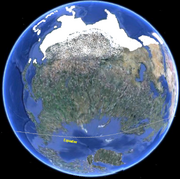
The Great Ice Age was a period of as long as a millennium before the first

records of human activity on the earth. It is known that there was activity, as cave drawings and tools have been found in the caves of modern day Asia that show that humans of some intellect lived in regions on the edge of the northern hemisphere's ice fields. In the southern hemisphere, though, there seems to have been no human presence until after the ice began to recede to present day polar conditions.
Many scholars, presenting conflicting information, postulate several ice ages lasting tens of thousands of years each. The best evidence, however, seems to indicate a single, sudden Ice Age that began to end as soon as it began. The massive and sudden deposit of very cold snow melted as the global temperature climbed from an average of 42°F to the present day 55.4°F (with variations along the way up and down). According to this evidence, most of the warming happened in the first five hundred years after the original event.
The Great Migration[]

Hamitic Wanderings
As mankind left its roots near the headwaters of the great rivers of East Asia - the Tigris and Euphrates - originating in the mountains east of the Black Sea, about half of the Hamitic peoples headed west across a vast plain to the south of the tallest mountains on earth - the Himalayan Range. They found ice beds where nothing could grow so they kept in the temperate zone just a bit cooler than the home region they had left.
The runoff from the glaciers and frozen rivers provided ideal conditions for forests and the animals that lived in them. However, as the clans separated, they found that the knowledge of their forefathers did not come "naturally." The wondering hunters found that they had to re-invent their world. Wild game on the plain proved dangerous, and many families found that caves were ideal for protection at night. The patriarchs would tell stories of times gone by, but mostly these were personal tales of hunting trips they had experienced themselves. The younger generations took to drawing pictures to preserve the stories. The pictures are seen even to this day on cave walls of homes long abandoned.
In the midst of their travels, some of these pilgrims would settle down along the rivers of the northern plains. The ones that most often settled, it turned out, were those that retained knowledge of life along the rivers of the original homeland. The Khindi peoples began to recall the old ways and sought to restore a belief in the God and/or gods of their ancestors. The religion that developed is said to be the "oldest religion in the world." As the ice receded into the mountains the branch of the Khindi that became "India" spread a little further towards the mountains, but for the most part the rivers defined their land.
Some of the wanderers, though, sought to find the 'edge of the world' where it was proposed that there was a great ocean wherein life abounded. These adventurous people stayed closer to the ice, having found that the animals of the ice fell faster to their weapons. Eventually, these same people would find that ocean, and even cross on the ice that covered it onto what they would discover as islands when the ice began to melt. The land known as 'Westland' today was the farthest the 'Eskimoes' would settle. Their way of life even today is a kindred with the icy polar waters.
Others, that had found the ice unbearable, migrated down the western coast into to found the lands of Khin, or China, in the vast coastal plain. Eventually they would migrate even further, both out to sea and into the tropical regions. But these migrations would be long after the "Ice Age" was over.
